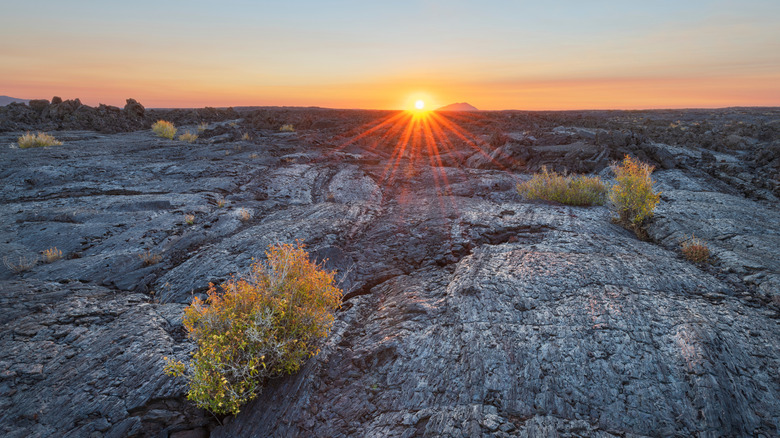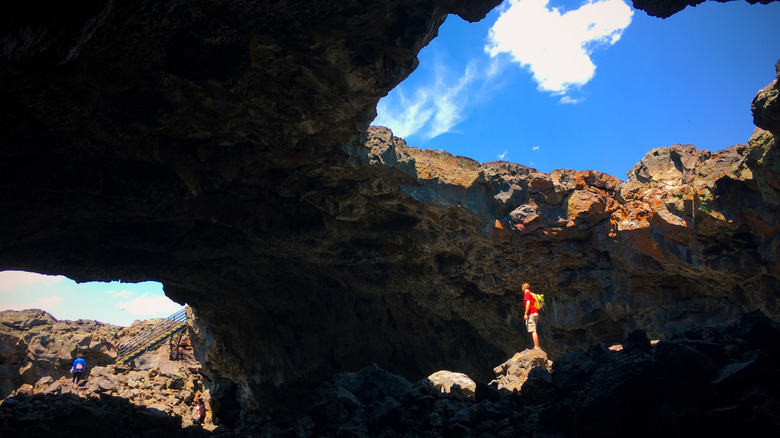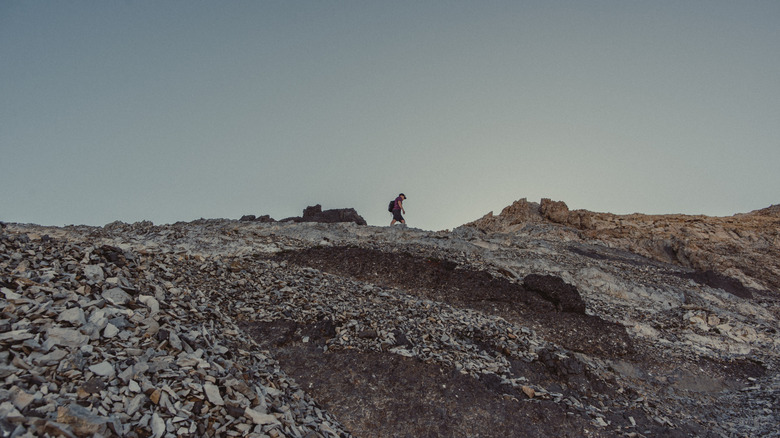Idaho's Most Surreal National Monument Is A Vast Lava Flow That Literally Feels Like Exploring The Moon
A surreal and desolate landscape on the fringes of the eastern Idaho desert is evidence of the region's violent volcanic past and a reminder of the power and beauty of nature. Craters of the Moon National Monument and Preserve, situated about 90 minutes west of Idaho Falls by car, is a massive 750,000-acre protected area that features everything from ice-cold caves to cinder cones and is one of the best places on earth to get a lesson in volcanic geology. Here, visitors can see lava flows that first erupted some 15,000 years ago and continued off and on until about 2,000 years ago. And geologists predict that, in time, the lava will flow again.
Visitors to this black-rock desert can wander miles of trails — most of which are less than two miles long. And, with a free cave permit obtained at the Craters of the Moon Visitors Center, adventurous wanderers can enter caves inside the park where molten hot lava once erupted to the surface. It's a landscape that can be so barren and seemingly free of life that NASA astronauts studied the geology here before the second trip to the moon.
For those whose feet are firmly rooted on earth, the 9-mile-long Loop Road is a great leisurely drive that features ample pull-offs and lots of interpretive information for those who have a thing for rocks and geology. Visitors can take short hikes from the Loop Road to see geologic features unique to the preserve. What's more, it's evidence of just how diverse Idaho is, as it's wholly unlike the lush Idaho mountains that dominate one of America's largest federally designated wilderness areas.
The Craters of the Moon volcano may not be active, but you will be
No, Craters of the Moon isn't a dramatic, steep-sloped volcano that many might expect when they think of the geological feature. Instead, Craters is a dormant volcano where past eruptions occurred along cracks in the earth's crust. Known as "fissure eruptions," the cracks cover over 52 miles throughout the preserve and form a massive geologic formation called the Great Rift. A quick stop at the Robert Limbert Visitors Center, just off of U.S. Highway 26 between the small Idaho towns of Arco and Carey, will give travelers the "lay of the land" when it comes to Craters of the Moon. Here, guests can take in the geological history of this unique American monument, and decide how they'll spend the rest of their time in this magical place. They'll have lots of options, too.
Visitors with just a few hours to spend in the park can access hiking trails near the visitor center that will take them to several features of the dormant volcano beneath their feet. For instance, guests who have half a day or less can easily wander the half-mile-long trail to Devil's Orchard, a limber pine woodland that sprung up out of some of the preserve's older lava flows. It's not a lush and scenic hike leading to majestic hideaways like the series of enchanting lakes hiding in the Albion Mountains, but it offers its own stark beauty, where casual walkers can wander a fully accessible trail and see, up close, some of the violent history associated with this dramatic swath of wild Idaho.
Backpacking across Idaho's alien landscapes
The remote location of Craters of the Moon National Monument and Preserve lends itself to adventurous travelers who love to get away from the crowds and enjoy truly wild places. Backpackers are welcome at Craters of the Moon, and backcountry camping is allowed on the preserve for guests who get a free permit. Fewer than 100 people every year acquire the free backcountry permit — this makes an overnight hike into the wilds of Craters of the Moon a very unique experience. For instance, backpackers can take the four-mile-long Wilderness Trail, which runs along some of the park's more notable landmarks, like Broken Top Cinder Cone and Big Cinder Butte. Here, you'll find several easy-to-identify backcountry campsites. One word of caution: there is no water in the Craters of the Moon backcountry. The National Park Service recommends hikers carry no less than one gallon of water for every day they plan to spend in the Craters wilderness.
Maybe the most dramatic way to see Craters of the Moon is on a clear summer night. Craters is a designated International Dark Sky Park, and, with no sources of light within 40 miles in any direction, the stars and the Milky Way really put on a show in the night sky. Idaho is loaded with dramatic views like those found along this spectacular backcountry wilderness road trip untouched by time, but nothing quite measures up to the sheer natural drama visitors can experience when they visit Craters of the Moon National Monument and Preserve. Its unique natural history and rugged landscapes are products of its super-heated and violent past, and there's simply no other place like it.


